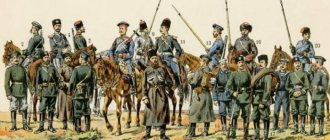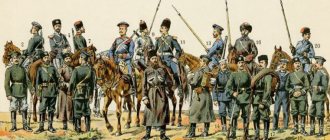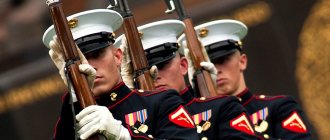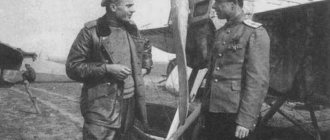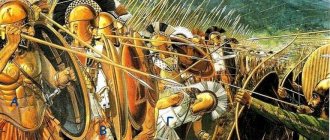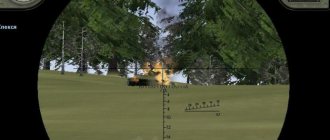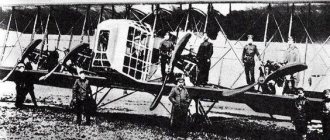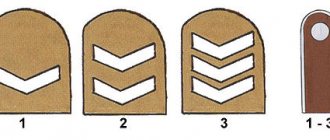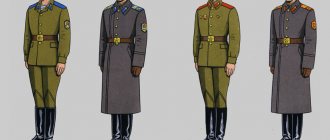A fighter’s high-quality uniform is the key to his combat effectiveness, confidence and pride in the country. Do you think the military uniform of the Russian army meets the stated requirements? Or does it leave much to be desired? Let's figure it out together. But first of all, you and I need to consider the military uniform of the Russian army by branch of service.
It should be noted that the new uniform of the Russian army appeared in 2015. Today every soldier has it. However, special rules for wearing it were created for the new uniform. You will learn about all this further in our article.
Main types of military uniforms
There are several types of military uniforms of the Russian army. It is divided into three types:
- Field - it is worn by military personnel during exercises, service, combat operations, as well as while providing assistance to civilians in case of emergencies or natural disasters.
- The ceremonial military uniform of the Russian army is worn by the military during various holidays and special events (including parades), as well as to receive awards at presentation ceremonies.
- Office - this type of military uniform is worn on any other occasions that do not belong to the first two types.
So, we got acquainted with the types of military uniforms of the Russian army. And now we move on to consider the global reform, thanks to which the appearance of the military forces has changed.
History of Russian military clothing
In Ancient Rus' there was practically no uniform for the military, since there were no permanent troops. Until the 17th century, each prince had at his disposal a squad, which was dressed in the usual clothes of that time. However, during an attack or defense of the city, its representatives wore protective armor on top.
The first attempt to create the same military uniform (clothing) was made during the formation of the Streltsy regiments in the 17th century. Then red caftans appeared, more than once painted by Russian artists in works of art (“Streltsy” by S. Ivanov and others). Such clothing was called a colored dress, and its color meant belonging to different regiments. There was also a ceremonial uniform that the archers wore during church holidays: it was supplemented with good-quality boots and a fur hat.
Team of Anatoly Serdyukov and Valentin Yudashkin
Unfortunately, in the history of Russia there have been several unsuccessful attempts to change the uniform of military personnel. While the Russian Federation's budget was being wasted on dress-up reforms, the appearance of the military forces of the United States of America was only improving. The kits became more convenient, their performance characteristics improved, and innovative materials were successfully tested.
But the time has come to change the military uniform of the Russian army, the photo of which you see below. The origin of this idea was in 2007. At that time, the post of Minister of Defense was occupied by Anatoly Serdyukov. On his orders, a large-scale competition was organized in the country, the commission considered a wide variety of sketches. It should be noted that more than 1000 fashion designers from all over Russia participated in this event.
As you may have guessed, the commission chose the sketches and sketches of Russian designer Valentin Yudashkin as the winner.
Psychology and history of uniforms
Every person has to wear a uniform more than once in their life. Everyone’s attitude towards this phenomenon is different, just as its social meaning and perception by many people differ. The main purpose of wearing any uniform is to show that a person belongs to a certain type of activity or social class.
Since ancient times, wearing certain clothes has determined a person's social status: better furs and fabrics are a sign of higher status in society. The very first military uniform in human history was the scarlet cloak worn by the Spartan warriors in Ancient Greece. Later, chain mail and coat of arms insignia on shields and flags became a distinctive attribute of the military.
Then uniforms began to appear not only as belonging to military personnel, but also clothing for schoolchildren and factory workers. In the Russian Empire, the first school uniform appeared in 1834 and became a source of pride for gymnasium students.
Wearing a military uniform embodies the idea of control and carries coded information about a person. A military man wearing a uniform is subject to certain rules, compliance with which is clearly defined by the regulations. This imposes some obligations and imprint on the personality, determines the rules of his behavior. Deviations from them are associated with disobedience and even sabotage, with the manifestation of individuality. Thus, wearing any uniform has a dual meaning on the person who wears it.
Wearing military uniforms and standard uniforms has a disciplinary effect on people and helps to influence the mind and body, since it presupposes the formation of a certain physique and military bearing. However, it also necessitates subordination, the transformation of the individual strength of one person into the collective power of an army. Military uniform is also an ideological tool, a means of shaping physical and mental activity.
Years of development
For two years, specialists and fashion designers from Valentin Yudashkin’s team were busy developing the final version of the modern military uniform of the Russian army. Ironically, the final result of the designers’ activities turned out to be similar to the American soldier’s uniform, but the project participants did not agree with this opinion, although a huge number of facts did not testify in their favor.
The winter military uniform of the Russian army was at the epicenter of criticism. The thing is that this type of clothing did not protect soldiers from the cold, so the Ministry of Defense received letters every day with complaints that the winter set of clothes for military personnel was not suitable in the cold season. As a result, outbreaks of colds began in military units in the northern regions of Russia.
But that's not all. Stylistic decisions were criticized, which, as it turned out, were copied from military clothing sets of other states.
Most of all, the military was upset by the threads and fabrics from which the clothes were made. The new uniform quickly wore out and became unusable.
The military uniform set of the Russian army consisted of 19 elements, and its cost was approximately 35,000 rubles!
Advantages of the new uniform of the Russian Army
Modern field uniforms for soldiers and officers are highly comfortable due to multi-layering (8 levels). In its production, membrane materials and other latest technologies are used, and special treatment of the seams is done. The kit contains a large number of items that are used depending on weather conditions and surroundings.
Basic levels of military uniform, rules for its configuration:
- 2 types of underwear (underwear and fleece for thermal insulation during the cold period);
- jackets (levels 3-4) - fleece for insulation and a windbreaker for cool weather;
- Soft Shell suit (5th), made of waterproof and windproof fabric with increased breathability, used as protective outerwear;
- windproof suit (6th), made of membrane material with “breathable” properties with numerous fasteners and zippers;
- insulated suit (level 7) - designed to protect against extreme cold conditions;
- a summer field suit made of cotton is worn in the outer layer in the summer;
- The period of wearing a military field uniform issued to military personnel is 3 years.
In 2016, 4 thousand sets were sewn for military personnel who serve in difficult northern conditions and in the Arctic. Such equipment is designed to protect a person from prolonged exposure to cold in strong winds and high humidity, during rain or snow.
Fashion designer's response to "uniform disgrace"
Due to the fact that the project failed again, Russian society began to blame fashion designer Valentin Yudashkin this time. In 2012, he held a press conference where he told reporters that the military uniforms commissioned were noticeably different from his models. To reduce the cost of the form, the materials chosen by the fashion designer were replaced with cheaper ones.
Journalists came to the consensus that only the appearance remained of Yudashkin’s uniform.
As a result, the Ministry of Defense revised its view of the new uniform and corrected shortcomings and shortcomings. Now let’s look at what a Russian army soldier wears today.
New military uniform from Yudashkin
As many people know, Yudashkin is a famous fashion designer who sews chic clothes within our country. Valentin took part in a qualifying competition for sewing a military collection and won it. In 2010, he produced a batch of 100,000 uniforms for military personnel.
What should the military uniform in Russia look like in Yudashkin’s eyes and what did he change?
- I moved the shoulder straps to the chest and sleeves.
- Began to produce a large number of Velcro parts
- The officers now have woolen sweaters.
- Overcoats were made fitted.
- The boots acquired a clearer, stricter and more elegant look.
It would seem that Yudashkin’s uniform has become the most ideal and graceful outfit in the last 10 years. But already in the cold winters of 2011-2012, the soldiers publicly voiced their discontent. It was expressed like this:
- Strong rustling noise when moving.
- Clothes tear and melt during exercises.
- Cold and not resistant to low temperatures.
In other words, Yudashkin's form failed. But the designer did not recognize him, disputing his participation in the creation of special clothing. Simply stated:
“The Russian Ministry of Defense has made radical changes to my collection..... I officially declare that I have no involvement in the creation of the uniform that the military wears now.”
Modern ceremonial set
For many years this type of form did not change. Its appearance meets all the requirements of modern times and at the same time pays tribute to the history of the centuries-old state. Only some elements of the uniform have been changed. Let's look at what the summer dress uniform consists of:
- woolen cap with band;
- ceremonial uniform with shoulder straps and buttonholes;
- dress trousers, ceremonial and weekend wool trousers of the 2010 model are allowed;
- uniform made of special cloth;
- White shirt;
- belt;
- a black tie, which should have a brass setting;
- low shoes or black chrome boots;
- White gloves.
Let's move on to the components of the winter dress uniform:
- hat with earflaps, decorated with gray fur;
- ceremonial weekend coat and uniform;
- uniform;
- trousers;
- white shirt, black tie, gloves and belt with the requirements for a summer uniform;
- black boots or demi-season low shoes.
Army of Peter I
Peter I re-equipped his army immediately after rearmament. The Russian army has already arrived at the walls of the Azov fortress in new shortened caftans. The German uniform became the model for the infantrymen's clothing: Peter's guards were dressed in a dark green cloth caftan, decorated with red cuffs with 4 copper buttons. A scarlet shoulder strap was attached to the left shoulder, onto which the sling of a bag with cartridges was hung. Underneath they wore a vesta camisole, which was fastened with small buttons, and even lower was a white shirt. Pants were made from good cloth, and for cavalrymen - from elk skin, knee-length. Below they wore stockings and blunt-toed shoes. For the hike, they were given boots, and in bad weather, a raincoat with a double collar.
The army and guards units differed in the color of their uniforms: the Semyonovtsy wore red and blue, the Preobrazhentsy wore red and green. Bow ties were also sewn for officers, which were tied around the neck, with the ends hanging down to the chest. the colors differed for different ranks and branches of the military.
The uniform of the officers was distinguished by a richer decor: embroidered gold braid on the cocked hat and caftan, silk multi-colored scarves with tassels (the colors of the Russian flag) and others. However, it was distinguished by its narrow cut and inconvenience when wearing.
Modern casual set
As you may have guessed, the color of the uniform will depend on the type of military service and rank. Generals and officers wear olive-colored casual uniforms. The Air Force wears blue uniforms. The headdress, that is, the cap, is the same color as the equipment. As before, the decorative elements on the cap are gold in color. Winter men's hats did not change.
Representatives of the fair sex in the military uniform of the Russian army now feel more feminine. The dresses and skirts they wear are figure-hugging, slightly emphasizing their curves. The female uniform has the same colors - olive or blue. During the cold season, ladies wear a short coat. Their head is decorated with an astrakhan beret, and in summer - an ordinary cap.
Military personnel with the rank of soldier, cadet or sergeant do not have a daily uniform. In winter and summer they wear field gear. In the cold season, they are warmed by a gray coat, with the exception of the Aerospace Forces and Airborne Troops - a blue uniform is sewn for them.
In the spring-autumn period, demi-season jackets are allocated for soldiers. In the summer, in bad weather, an elongated raincoat is issued that does not allow moisture to pass through.
Modern office suite
This type of clothing is considered a type of casual uniform. It is worn by generals, officers and employees of the Ministry of Defense. The set includes: a cap, a shirt of the same color, a white T-shirt and plain trousers in the color of the headdress.
In the winter season, military personnel wear a warm jacket to which a hood is attached, and a hat with earflaps warms their head.
The office uniform undergoes slight changes every year. It is strictly forbidden to wear such clothing in the field.
Form after the revolution
After 1917, during the Civil War, the uniform of the Red Army was not unified: the only distinctive feature was a scarlet ribbon with the inscription “Red Guard”, which was worn on a sleeve or hat. In 1918, an original cloth headdress appeared, which was later called “Budenovka” (at first it was called “heroka”). Shoulder straps were abolished, replaced by distinctive squares and triangles that could be used to identify rank and troops.
The wearing of the emblem in the form of a red star was approved in May 1918, which became a symbol of the young state. It was worn on an overcoat, jacket, tunic, etc.
In 1922, the Revolutionary Military Council issued a decree on the transition to new regulated uniforms, and the old uniform was canceled. Much attention was paid to insignia, which were sewn onto the sleeve flap, buttonholes and other forms. They differed in color, shape, etc. The basic uniform consisted of a cloth overcoat and helmet, a tunic shirt, riding breeches, boots or boots. The cloth used was dark gray made of wool, the shirt was gray made of dyed cotton fabric.
